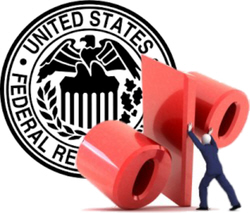MORTGAGE RATES, TARIFF NEWS, AND VOLATILITY WHEN IS IT A GOOD TIME TO REFINANCE?

FED RAISES RATES BY 25 BASIS POINTS, FIRST SINCE 2006
At long last, a rate hike for the history books.
After seven years of the most accommodative monetary policy in U.S. history, the Fed on Wednesday, as widely expected, approved a quarter-point increase in its target funds rate. The new target will go from 0 percent to 0.25 percent to 0.25 percent to 0.5 percent. Most members expect the new rate to coalesce around .375 percent before the next hike, according to a chart showing individual member expectations.
 The decision, given the official stamp of approval from the Federal Open Market Committee, marks the first increase since the panel pushed the key rate to 5.25 percent on June 29, 2006. In a succession of moves necessitated by the financial crisis and the Great Recession that officially ended in mid-2009, the FOMC took the rate to zero exactly seven years ago, on Dec. 16, 2008.
The decision, given the official stamp of approval from the Federal Open Market Committee, marks the first increase since the panel pushed the key rate to 5.25 percent on June 29, 2006. In a succession of moves necessitated by the financial crisis and the Great Recession that officially ended in mid-2009, the FOMC took the rate to zero exactly seven years ago, on Dec. 16, 2008.
“Given the economic outlook, and recognizing the time it takes for policy actions to affect future economic conditions, the committee decided to raise the target range for the federal funds rate to ¼ to ½ percent,” the FOMC’s post-meeting statement said. “The stance of monetary policy remains accommodative after this increase, thereby supporting further improvements in labor market conditions and a return to 2 percent inflation.”
There were no dissents, even though multiple FOMC members publicly over the past few months have expressed reservations about rate hikes. The committee also voted to raise the discount rate a quarter-point to 1 percent.
In addition to the usual documents released with the post-meeting statement, the Fed also put out a statement outlining the mechanics of how the new rate will come to pass. The program will be an ambitious one, involving $2 trillion of securities that will be used in overnight trading to push the rate into the desired range. However, the FOMC statement said it will be some time before the Fed starts unwinding its mammoth $4.5 trillion balance sheet.
“The premise behind today’s rate hike to me feels a little stagflationary. They didn’t raise rates today because real growth got a lot strong. In fact, if anything it got weaker, but they raised them anyway,” said Jim Paulsen, chief market strategist at Wells Capital Management, following the decision. “If we go through 2016 where real growth doesn’t pick up but wage and price pressures do because we’re in full employment, that’s stagflationary.”
Despite the history-making move, the road back to normalcy will be a long one. FOMC officials made it excessively clear in post-meeting documents that the pace of increases will be gradual and dependent on the quality of economic data. The projections and statement following the meeting reflected an effort to deliver the “dovish hike” many on Wall Street had been forecasting.
“The committee expects that economic conditions will evolve in a manner that will warrant only gradual increases in the federal funds rate; the funds rate is likely to remain, for some time, below levels that are expected to prevail in the longer run,” the post-meeting statement said. “However, the actual path of the federal funds rate will depend on the economic outlook as informed by incoming data.”
The statement also added this sentence to ensure markets that the pace will be slow: “The committee currently expects that, with gradual adjustments in the stance of monetary policy, economic activity will continue to expand at a moderate pace and labor market indicators will continue to strengthen.”



